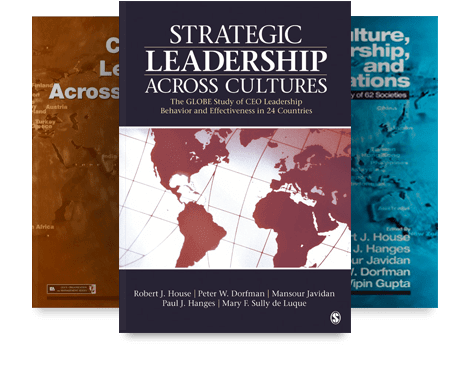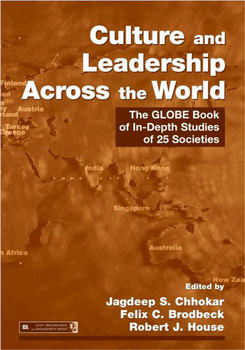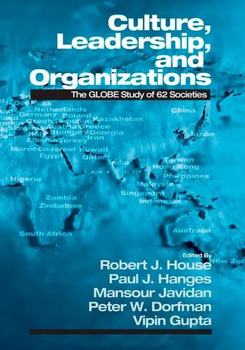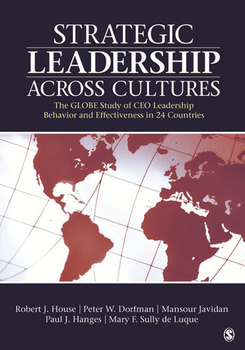An overview of the 2004 study: Understanding the Relationship Between National Culture, Societal Effectiveness and Desirable Leadership Attributes
The GLOBE (Global Leadership and Organizational Behavior Effectiveness) research program was founded by Robert House in 1991. GLOBE became a multi-phase, multi-method, multi sample research project in which investigators spanning the world are examined the interrelationships between societal culture, societal effectiveness and organizational leadership. Since 1991, the GLOBE research program has continued in three distinct but interrelated phases. The following is a brief description of the major objectives and findings of the program published in 2004 and 2007. A description and results of the latest 2014 CEO GLOBE study can be found elsewhere in this GLOBE website.
Societal Culture
The term culture typically refers to a set of parameters of collectives that differentiate each collective in a meaningful way, with a focus on the “sharedness” of cultural indicators among members of the collective. For Project GLOBE, culture is defined as follows:
Shared motives, values, beliefs, identities, and interpretations or meanings of significant events that result from common experiences of members of collectives that are transmitted across generations.
In the first phase of the GLOBE project, researchers identified and developed measures of societal culture. Hundreds of items related to societal culture were assessed in several pilot studies. They were analyzed by conventional psychometric procedures (e.g., item analysis, factor analysis, generalizability analysis) to establish nine dimensions of societal culture. By the end of this process, over 17000 middle managers in 62 cultures participated in the study to measure cultural values and practices in each country. We were thus able to provide a rigorous large scale comparison of cultural values and practices in many parts of the world.
Listed here are brief definitions of the nine cultural dimensions. Culture construct definitions, example questionnaire items, and national exemplars of the extremes are presented in House, et al., 2004).
- Performance Orientation: The degree to which a collective encourages and rewards (and should encourage and reward) group members for performance improvement and excellence.
- Assertiveness: The degree to which individuals are (and should be) assertive, confrontational, and aggressive in their relationship with others.
- Future Orientation: The extent to which individuals engage (and should engage) in future-oriented behaviors such as planning, investing in the future, and delaying gratification.
- Humane Orientation: The degree to which a collective encourages and rewards (and should encourage and reward) individuals for being fair, altruistic, generous, caring, and kind to others.
- Institutional Collectivism: The degree to which organizational and societal institutional practices encourage and reward (and should encourage and reward) collective distribution of resources and collective action.
- In-Group Collectivism: The degree to which individuals express (and should express) pride, loyalty, and cohesiveness in their organizations or families.
- Gender Egalitarianism: The degree to which a collective minimizes (and should minimize) gender inequality.
- Power Distance: The extent to which the community accepts and endorses authority, power differences, and status privileges.
- Uncertainty Avoidance: The extent to which a society, organization, or group relies (and should rely) on social norms, rules, and procedures to alleviate unpredictability of future events. The greater the desire to avoid uncertainty, the more people seek orderliness, consistency, structure, formal procedures, and laws to cover situations in their daily lives.
Leadership and GLOBE’s Culturally Endorsed Leadership Theory (CLT)
The GLOBE research team defined leadership as the ability of an individual to influence, motivate, and enable others to contribute toward the effectiveness and success of the organizations of which they are members (House et al, 2004). We extended the concept of implicit leadership theory (Lord & Maher, 1991) to the level of national culture and hypothesized that members of different societies may have differing expectations from their leaders, influenced by their cultural values.
GLOBE designed a questionnaire with 112 leader attributes and behaviors items which included a wide variety of traits, skills, behaviors, and abilities potentially relevant to leadership emergence and effectiveness. The statistical analysis on our data from the survey of over 17,000 managers in sixty-two societies (House et al., 2004) produced 21 primary dimensions of leadership. To further understand the underlying construct of CLTs, a second-order factor analysis of these 21 dimensions produced a set of what we refer to as 6 global leadership dimensions. The six global dimensions and their associated 21 primary leadership dimensions constitute our notion of culturally endorsed leadership theory (CLT) and are briefly defined as follows:
- Charismatic/Value-Based Leadership: Reflects the ability to inspire, motivate, and expect high performance outcomes from others based on firmly held core values. It includes the following six primary leadership dimensions: (a) visionary, (b) inspirational, (c) self-sacrifice, (d) integrity, (e) decisive and (f) performance oriented.
- Team-Oriented Leadership: Emphasizes effective team building and implementation of a common purpose or goal among team members. It includes the following five primary leadership dimensions: (a) collaborative team orientation, (b) team integrator, (c) diplomatic, (d) malevolent (reverse scored), and (e) administratively competent.
- Participative Leadership: Reflects the degree to which managers involve others in making and implementing decisions. It includes two primary leadership dimensions labeled (a) nonparticipative and (b) autocratic (both reverse scored).
- Humane-Oriented Leadership: Reflects supportive and considerate leadership and includes compassion and generosity. This leadership dimension includes two primary leadership dimensions labeled (a) modesty and (b) humane orientation.
- Autonomous Leadership: Refers to independent and individualistic leadership attributes. It is measured by a single primary leadership dimension labeled autonomous leadership, consisting of individualistic, independence, autonomous, and unique attributes.
- Self-Protective Leadership: Focuses on ensuring the safety and security of the individual and group through status enhancement and face saving. It includes five primary leadership dimensions labeled (a) self-centered, (b) status conscious, (c) conflict inducer, (d) face saver, and (e) procedural.
Findings and Conclusions
GLOBE researchers were able to measure and validate country (and country cluster) scores for each of the nine culture dimensions. For each culture dimension, country scores were identified as to the present existence of the culture dimension (“as is” scores) and the values as to what the country aspires to be (“should be” scores). We show the differential association between various cultural dimensions and measures of societal achievement and confirmed a clear cultural underpinning to the way societies generate and distribute wealth and take care of their people. For example, high performance oriented societies are generally more economically successful and enjoy higher levels of human development than societies with lower performance orientation. We also have identified the universally desirable cultural dimensions like performance orientation and the universally undesirable dimensions like power distance. We used the existing literature to develop a conceptual clustering of societies and empirically validated them. The clusters are the first empirical attempt to use a holistic approach to understand and verify cultural differences across societies. We now have cluster scores on cultural values, practices, and implicit leadership theories.
From the perspective of leadership attributes and its relationship to societal culture, we identified 21 primary and 6 global leadership dimensions. From these, we created endorsed leadership profiles across the 10 culture clusters, which, in turn, follow from the development of our culturally implicit leadership theory (CLT). We have also identified universally desirable, universally undesirable, and culturally contingent attributes of leadership. Hierarchical linear modeling (HLM) was used to explore the relationships at different levels of analysis using alternate data sources in a way that eliminates common source bias. Our findings show many relationships among cultural dimensions, organizational practices, and culturally endorsed (i.e., CLT) leadership dimensions. In terms of the relationship between leadership and culture, we have identified the cultural dimensions that can best predict CLT dimensions and assessed the differential strength of association between each cultural dimension in relation to each CLT dimension. As one example, societies that value high performance orientation desire leaders who are charismatic, team oriented, and participative.
We should note that the GLOBE 2007 book was structurally different from the GLOBE 2004 book. The former was structured around nine cultural dimensions whereas the latter provided in-depth country-specific analyses of cultural values, practices, and leadership expectations. The latter also included extensive findings from a variety of qualitative analyses along with the quantitative findings in GLOBE 2004. In GLOBE 2007, we also described from each other (and within each cluster) regarding differences in perceptions of effective leadership qualities.
Additional Reading
Instruments Phase 2
The following links will explain the ways in which GLOBE Phase 2 instruments can be used by other researchers. Please read the guidelines and used the syntax link to compute different variables.
- GLOBE Culture and Leadership Scales Guidelines: Aug. 1, 2006
- GLOBE Syntax for GLOBE National Culture, Organizational Culture and Leadership Scales: 2006
Questionnaires
The following links contain the GLOBE Phase 2 actual questionnaires (Alpha and Beta). Please see the guide above for clarification and details. There are also links to translated questionnaires in other languages.
Countries surveyed
GLOBE’s multi-phase, multi-method project involves approximately 200 co-country investigators researching 950 organizations in over 60 countries, in phase level 2. GLOBE researchers examine the interrelationships between societal culture, organizational culture and organizational leadership.
In phase 3, 24 countries were involved of which 18 were from phases 1 and 2 and 6 new countries.
A
- Albania
- Argentina
- Australia
- Austria
- Azarbaijan*
B
- Bolivia
- Brazil
C
- Canada (English Speaking)
- China
- Colombia
- Costa Rica
- Czech Republic
D
- Denmark
E
- Ecuador
- Eqypt
- El Salvador
- England
F
- Fiji*
- Finland
- France
G
- Georgia
- Germany (former GDR)
- Germany (former FRG)
- Greece
- Guatemala
H
- Hong Kong
- Hungary
I
- India
- Indonesia
- Iran
- Ireland
- Israel
- Italy
J
- Japan
K
- Kazakhstan
- South Korea
- Kuwait
L
- -
M
- Malaysia
- Mexico
- Morocco
N
- Namibia
- Netherlands
- New Zealand
- Nicaragua
- Nigeria
O
- -
P
- Peru*
- Philippines
- Poland
- Portugal
Q
- Qatar
R
- Russia
S
- Singapore
- Slovenia
- Solomon Islands*
- South Africa (Black sample)
- South Africa (White sample)
- Spain
- Sweden
- Switzerland
T
- Tonga*
- Taiwan
- Thailand
- Turkey
U
- United States
V
- Vanuatu*
- Venezuela
WXY
- -
Z
- Zambia
- Zimbabwe
Co-country Investigators
GLOBE country co-investigators (CCIs). We have developed a network of over 200 social scientists from around the world who constitute the members of the GLOBE community. CCIs are responsible for leadership of the project in a specific country or countries in which they have expertise. Most countries have between two and five CCIs working on the project as a research team.
Complete directory of CCI lists:
Data Phase 2
The following provides the actual scores for countries from the Phase 2 GLOBE study. Please use these labels to interpret the headings in the following May 17, 2004, Excel files:
Original GLOBE culture survey items
GLOBE Books
The GLOBE books represent results from a twenty-year research program investigating the influence of culture on societal and organizational effectiveness. Our latest book showcases our examination of strategic leadership effectiveness for top-level management based on data from more than 1,000 CEOs and over 6,000 top-level managers in 24 countries.
View



